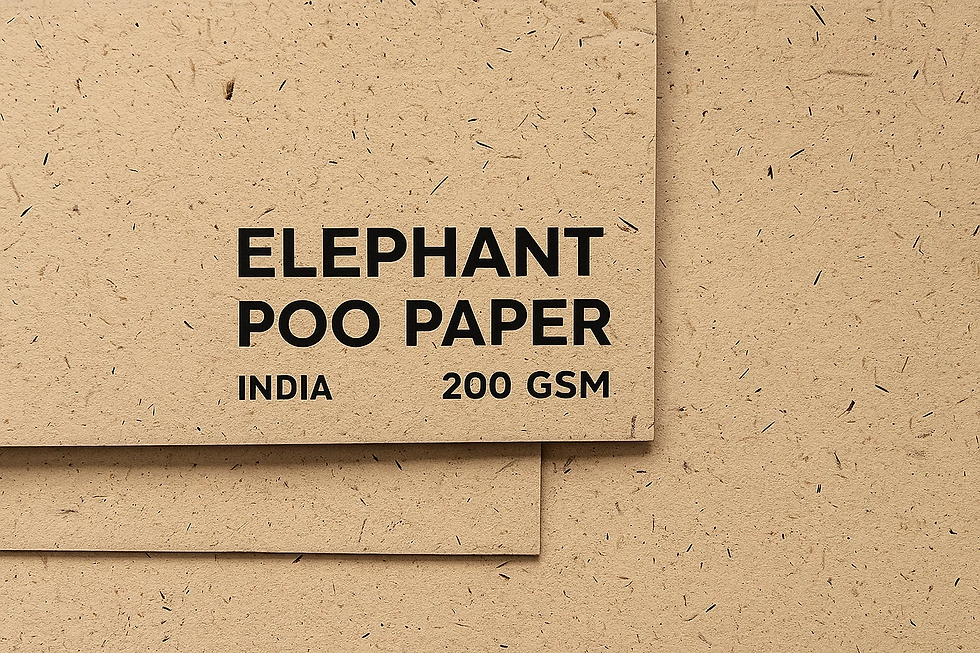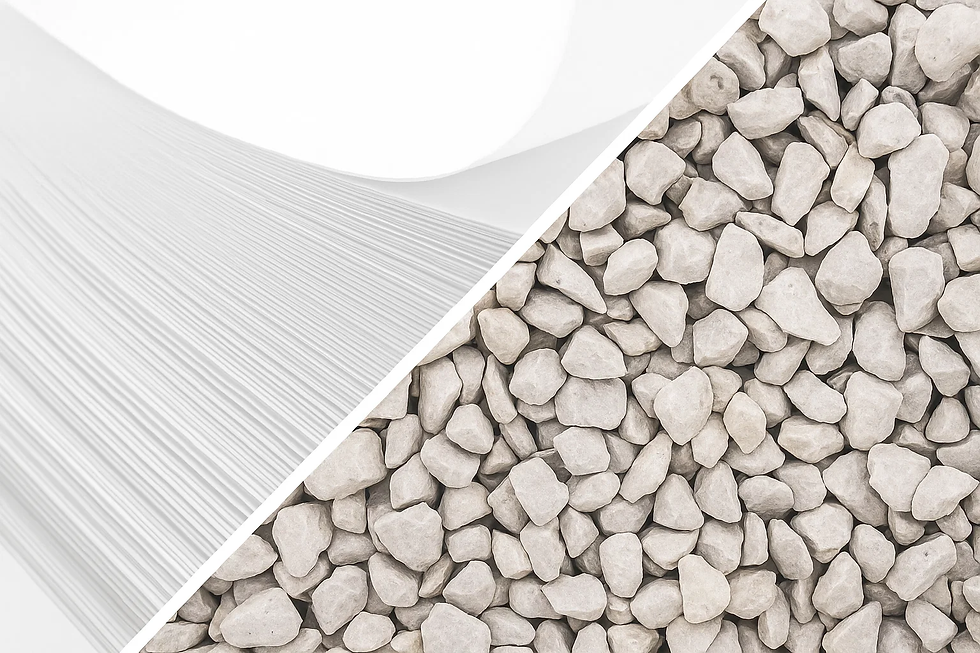A Guide to Some Sustainable Paper Materials: Smarter Choices
- Leo Xia

- Aug 6
- 5 min read
Updated: Aug 28
Quick Content Reach:
Sustainability Is No Longer a Trend—It's a Standard
As a seasoned Notebook & Journal Manufacturer, we’ve seen a sharp shift in how buyers approach their sourcing decisions. Today’s retailers and distributors are no longer looking for the cheapest product; they want environmentally responsible, ethically produced, and competitively priced paper products that reflect their brand values.
In this comprehensive guide, I’m sharing deep industry insights into some of the most innovative and sustainable paper materials available in the global stationery market today. These aren't just trends—they’re transformations that your business can leverage for long-term growth and consumer trust.
If you're a purchasing manager or buyer, especially from regions like the U.S., UK, Germany, or Australia, I encourage you to connect with Lion Paper Products. Let’s co-create stationery that resonates with your customers and your sustainability goals. Contact us here or chat on WhatsApp: +86 13750756354.
1. Coffee Paper: A Natural Outcome of Circular Design
Coffee paper is crafted from the husks of coffee beans—materials that would otherwise end up in landfills. These husks are processed into a pulp and transformed into paper with a rich, earthy tone and tactile texture. It’s particularly favored by eco-conscious brands seeking sustainable yet visually unique packaging or stationery.
Key Benefits:
Reduces agricultural waste
Contains no bleaching agents
Strong consumer appeal in eco-sensitive markets
This material has become popular among high-end cafes, boutique notebook brands, and small businesses that value storytelling in packaging. It also performs well with soy-based inks and letterpress techniques.

Are you looking to launch an eco-conscious notebook collection? Lion Paper Products can provide customized coffee paper notebooks within 7 days for sample turnaround. Send an inquiry now.
2. Cacao Paper: Where Luxury Meets Sustainability
Cacao paper is made from cocoa bean husks, a byproduct of the chocolate industry. Its deep brown tone and silky finish make it ideal for premium stationery, luxury journals, or promotional brochures for gourmet products.
Why Cacao Paper Works:
Upcycles waste from the booming chocolate industry
High visual appeal for food, beverage, and luxury brands
Compatible with foil stamping, making it suitable for upscale branding
With sustainability expectations rising in Europe and Australia, cacao paper helps you align brand image with responsible sourcing.

Contact us to help you create a high-impact Eco-friendly product line.
3. Lavender Paper: Elegance With a Scented Signature
Lavender paper is made from leftover lavender stalks after oil extraction. The result? A soft purple hue and subtle scent—making it the preferred paper material for invitations, gift bags, and high-end packaging.
Notable Characteristics:
Made from 100% natural post-agricultural waste
Natural fragrance offers sensory differentiation
Excellent for embossed branding
Buyers for boutique stores, wedding planners, or spa brands can add lavender paper notebooks to diversify their product lines.

4. Elephant Dung Paper: A Bold Statement in Eco Creativity
Yes, it’s real—and yes, it works. Elephant dung paper is made from the high-fiber dung of plant-eating elephants. After a thorough cleaning and pulping process, the resulting paper is surprisingly smooth and clean.
Benefits You Can Share With Customers:
Unique origin story attracts attention
Contributes to wildlife conservation and local economies
Naturally textured and 100% biodegradable
This paper has been used by eco-tourism businesses, nature conservancies, and wildlife foundations to tell impactful stories.

5. Tyvek: Synthetic, Yet Surprisingly Sustainable
Tyvek is a synthetic paper alternative made from high-density polyethylene fibers. While not organic, its extremely long lifecycle and reusability make it a surprising contender for sustainability-focused buyers.
Use Cases:
Tear-proof and waterproof, perfect for outdoor notebooks and planners
Popular for field use, especially in education and government sectors
Compatible with laser printing and thermal transfer printing
From South African school kits to government field journals in Qatar, Tyvek offers rugged performance.

Lion Paper Products is experienced in binding Tyvek-based notebooks that survive the toughest environments. Reach out to discuss your specs.
6. Recycled Cotton Paper: Breathing New Life Into Textiles
This sustainable paper is made from cotton rags collected from textile factories, often post-production waste. It’s soft, durable, and carries a luxurious feel.
Ideal For:
Luxury planners and journals
Artist sketchbooks
Cultural projects and museum merchandise
Recycled cotton paper aligns well with ethical sourcing goals and appeals to European buyers in fashion and design-centric markets.

Lion Paper Products can help you integrate this material into your collections while meeting ISO and FAMA standards. Let’s talk customizations.
7. Stone Paper: A Durable, Tree-Free Option
Made from calcium carbonate and non-toxic resin, stone paper doesn’t use water or trees in its production. It’s naturally white, waterproof, and extremely durable.
Advantages Include:
High resistance to tearing and moisture
Smooth writing surface for pens and markers
Long-lasting, making it ideal for planners and calendars
Stone paper is especially relevant in high-humidity countries like Singapore or coastal areas in Australia.

Lion Paper Products can test your sample requests in our own climate simulation lab. Request a sample.
8. Bamboo Paper: Fast-Growing and Highly Renewable
Bamboo regenerates in just 3–5 years, making it a popular alternative to traditional wood pulp. Bamboo paper is both strong and soft, ideal for journals and notepads.
Reasons to Choose Bamboo Paper:
FSC-certified bamboo sources available
Lower carbon footprint compared to wood-based paper
Smooth finish works well for luxury brands and sustainable school supplies

If you aim to align with sustainability metrics required by retailers or government procurement bodies, bamboo paper notebooks can enhance your product line. Let’s co-develop your sustainable stationery range.
9. Sugarcane Bagasse Paper: Turning Waste Into Opportunity
Sugarcane bagasse is the fibrous residue left after juice extraction. It's widely used in packaging and increasingly adopted in paper making.
Industry Use Cases:
Calendar printing
Custom notepads for food and beverage brands
Retail packaging with a sustainable story

We’ve seen growing interest in sugarcane-based paper from clients in Spain and the U.S., especially in food-related sectors. Explore this material with us.
Sustainable Paper Material Comparison Table
Paper Type | Key Feature | Ideal Use Example |
Coffee Paper | Textured, recycled | Eco notebooks |
Cacao Paper | Smooth, dark finish | Luxury journals |
Lavender Paper | Scented, soft feel | Gift packaging |
Elephant Paper | Unique & green | Eco cards |
Tyvek | Waterproof, strong | Outdoor notebooks |
Cotton Paper | Soft, premium feel | Sketchbooks |
Stone Paper | Tree-free, durable | Planners, calendars |
Bamboo Paper | Fast-growing source | School stationery |
Sugarcane | Made from waste | Notepads, packaging |
Conclusion: Partner With a Notebook & Journal Manufacturer Who Knows Sustainable Paper Materials
As global demand for eco-responsible stationery increases, sourcing from the right manufacturer is more crucial than ever. At Lion Paper Products, our mission is to help your business succeed while aligning with modern sustainability standards.
With production bases in China and Cambodia and a partner factory in South Korea, we’re ready to serve your needs with speed, reliability, and compliance.
Let’s build better products—responsibly.
—Leo Xia, CEO, Lion Paper Products
You design, we deliver.
FAQs:
Q1: What is the most eco-friendly paper material for notebooks?
A: Recycled cotton paper and coffee paper are among the top choices.
Q2: Can Tyvek be recycled?
A: Yes, Tyvek is 100% recyclable.
Q3: Is elephant dung paper hygienic and safe?
A: Absolutely. It's thoroughly cleaned and safe for writing.
Q4: Are scented papers like lavender paper allergy-friendly?
A: Yes, the fragrance comes from natural plant extracts and is low-risk.
Are you looking for a reliable manufacturer? Reach out to Lion Paper for a free quote and consultation. Let’s collaborate on creating custom writing paper products that will set your brand apart from the competition!




Comments